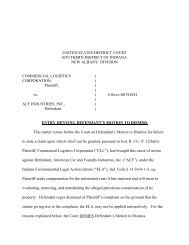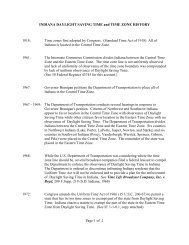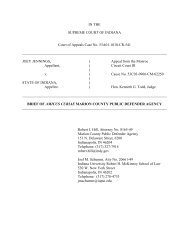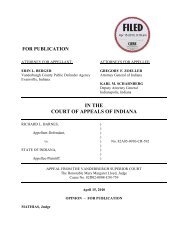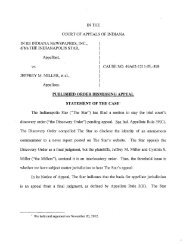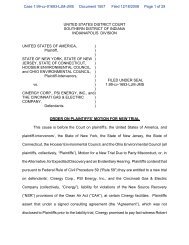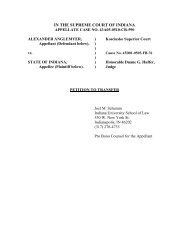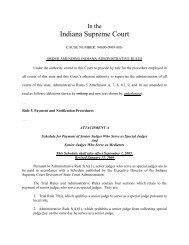Deborah Walton v. City of Carmel - The Indiana Law Blog
Deborah Walton v. City of Carmel - The Indiana Law Blog
Deborah Walton v. City of Carmel - The Indiana Law Blog
You also want an ePaper? Increase the reach of your titles
YUMPU automatically turns print PDFs into web optimized ePapers that Google loves.
NONPRECEDENTIAL DISPOSITION<br />
To be cited only in accordance with<br />
Fed. R. App. P. 32.1<br />
United States Court <strong>of</strong> Appeals<br />
For the Seventh Circuit<br />
Chicago, Illinois 60604<br />
Submitted October 30, 2008<br />
Decided December 10, 2008<br />
Before<br />
WILLIAM J. BAUER, Circuit Judge<br />
JOHN L. COFFEY, Circuit Judge<br />
MICHAEL S. KANNE, Circuit Judge<br />
No. 07‐3728<br />
DEBORAH WALTON,<br />
Plaintiff‐Appellant,<br />
v.<br />
CITY OF CARMEL, et al.,<br />
Defendants‐Appellees.<br />
Appeal from the United States District<br />
Court for the Southern District <strong>of</strong> <strong>Indiana</strong>,<br />
<strong>Indiana</strong>polis Division.<br />
No. 1:05‐cv‐902‐RLY‐TAB<br />
Richard L. Young,<br />
Judge.<br />
O R D E R<br />
When <strong>Deborah</strong> <strong>Walton</strong> purchased her home in <strong>Carmel</strong>, <strong>Indiana</strong>, in 2000, she agreed<br />
to a host <strong>of</strong> covenants and restrictions—chief among them an easement permitting the<br />
Claybridge Homeowners Association (CHA) to maintain an entry wall and sign on a corner<br />
<strong>of</strong> her property. That wall runs to the edge <strong>of</strong> an adjacent road, and by doing so it interferes<br />
with the <strong>City</strong> <strong>of</strong> <strong>Carmel</strong>’s right‐<strong>of</strong>‐way (i.e. the road shoulder). After <strong>Walton</strong> notified the<br />
city <strong>of</strong> the problem (and requested that the city remove the entire wall), the city contacted<br />
the CHA. <strong>The</strong> CHA proposed a substitute solution—that the city consent to the<br />
encroachment on to its right‐<strong>of</strong>‐way. To that end the CHA filed a formal request, which the<br />
<strong>Carmel</strong> Board <strong>of</strong> Public Works and Safety approved following a public hearing.
No. 07‐3728 Page 2<br />
<strong>Walton</strong> responded by suing the <strong>City</strong> <strong>of</strong> <strong>Carmel</strong>, its mayor, the city attorney, the<br />
CHA, and various other individuals under 42 U.S.C. § 1983, claiming that the city’s consentto‐encroachment<br />
deprived her <strong>of</strong> property without due process <strong>of</strong> law. According to<br />
<strong>Walton</strong>, her lot runs to the middle <strong>of</strong> the street—which we will assume to be true for the<br />
purposes <strong>of</strong> this appeal only, see Madison v. Frazier, 539 F.3d 646, 652 (7th Cir. 2008)—and<br />
thus the city and the CHA needed her permission before the city could consent to the<br />
encroachment. <strong>The</strong> district court granted summary judgment for the defendants, though,<br />
reasoning that the city consented only “to CHA’s wall encroaching on whatever property<br />
interest [the city] has in the right‐<strong>of</strong>‐way,” nothing more. Thus, the court concluded,<br />
<strong>Walton</strong>’s property rights were unaffected. <strong>Walton</strong> insists otherwise on appeal.<br />
We review a district court’s grant <strong>of</strong> summary judgment de novo. Squibb v. Mem’l<br />
Med. Ctr., 497 F.3d 775, 780 (7th Cir. 2007). To withstand summary judgment, <strong>Walton</strong>, as<br />
the nonmoving party, must provide specific facts such that a jury could reasonably find in<br />
her favor. See Anderson v. Liberty Lobby, Inc., 477 U.S. 242, 248 (1986).<br />
<strong>Walton</strong> renews her argument on appeal that her property reaches “to the center <strong>of</strong><br />
the street, despite the existence <strong>of</strong> the right <strong>of</strong> way,” and therefore the city needed her<br />
permission before it could consent to the encroachment. But <strong>Walton</strong> cannot get past the<br />
fatal defect identified by the district court: the record shows that the city agreed only to<br />
abandon any objection it had to the encroachment on the city’s right‐<strong>of</strong>‐way; nothing about<br />
the consent agreement ratifies an intrusion on <strong>Walton</strong>’s property (whatever its dimensions).<br />
And <strong>Walton</strong> acknowledges that the right‐<strong>of</strong>‐way itself does not belong to her. We agree<br />
with the district court’s reasoning and the magistrate judge’s report, which aptly<br />
summarizes <strong>Walton</strong>’s theory and its failing:<br />
Plaintiff seems to be arguing that <strong>Carmel</strong> is required to protect whatever<br />
interest she has in the [land on which the right‐<strong>of</strong>‐way sits] by not giving up<br />
its rights without her consent, and if <strong>Carmel</strong> fails to do so, then she is<br />
deprived <strong>of</strong> due process under the Fifth and Fourteenth Amendments.<br />
Because the Constitution does not impose this requirement on <strong>Carmel</strong>,<br />
Plaintiff’s due process claim fails.<br />
<strong>Walton</strong> has no right under the Constitution to the affirmative assistance <strong>of</strong> the government<br />
in protecting her property. See DeShaney v. Winnebago County Depʹt <strong>of</strong> Soc. Servs., 489 U.S.<br />
189, 195‐96 (1989). Accordingly, the judgment <strong>of</strong> the district court is<br />
AFFIRMED.



